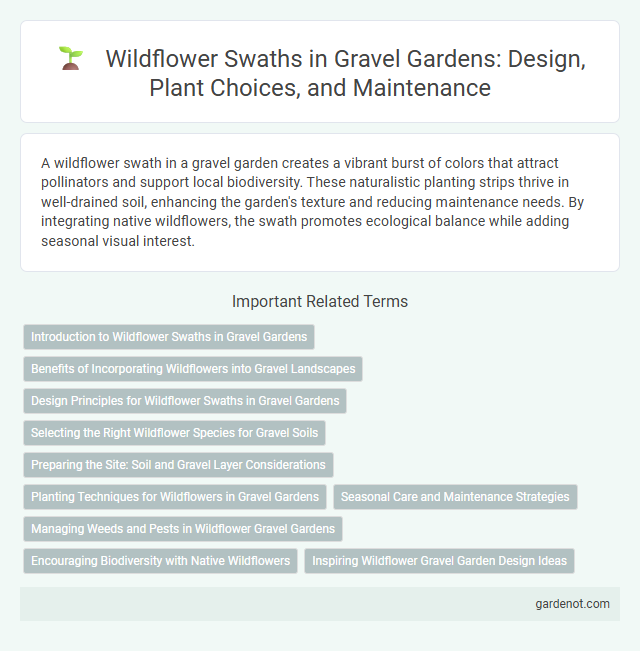A wildflower swath in a gravel garden creates a vibrant burst of colors that attract pollinators and support local biodiversity. These naturalistic planting strips thrive in well-drained soil, enhancing the garden's texture and reducing maintenance needs. By integrating native wildflowers, the swath promotes ecological balance while adding seasonal visual interest.
Introduction to Wildflower Swaths in Gravel Gardens
Wildflower swaths in gravel gardens create vibrant, low-maintenance ecosystems that enhance biodiversity and attract pollinators such as bees and butterflies. These swaths consist of drought-tolerant wildflower species adapted to well-drained, poor soil conditions typical of gravel beds. Incorporating native wildflowers like poppies, cornflowers, and ox-eye daisies ensures ecological balance while maintaining aesthetic appeal throughout the growing season.
Benefits of Incorporating Wildflowers into Gravel Landscapes
Incorporating wildflower swaths into gravel gardens enhances biodiversity by attracting pollinators such as bees and butterflies, which are essential for ecosystem health. Wildflowers improve soil structure and moisture retention within gravel landscapes, reducing erosion and supporting plant resilience. These vibrant blooms also add seasonal color and texture, creating visually appealing and low-maintenance outdoor spaces.
Design Principles for Wildflower Swaths in Gravel Gardens
Wildflower swaths in gravel gardens optimize biodiversity while complementing minimalist design by integrating native, drought-tolerant species that thrive in poor soils. Strategic placement considers sunlight exposure, soil drainage, and seasonal bloom cycles to maintain visual interest and ecological balance. Employing mixed species with varying heights and textures enhances soil stabilization and creates dynamic habitats for pollinators within the gravel garden ecosystem.
Selecting the Right Wildflower Species for Gravel Soils
Choosing wildflower species adapted to well-drained, nutrient-poor gravel soils is essential for a thriving gravel garden wildflower swath. Select drought-tolerant plants such as yarrow (Achillea millefolium), cornflower (Centaurea cyanus), and oxeye daisy (Leucanthemum vulgare) that flourish in sandy, gravelly substrates. Prioritizing native species suited to local climate conditions enhances biodiversity and reduces maintenance requirements in gravel garden environments.
Preparing the Site: Soil and Gravel Layer Considerations
Preparing the site for a wildflower swath in a gravel garden requires careful soil assessment to ensure proper drainage and nutrient levels. Incorporate a well-draining gravel layer topped with a thin, nutrient-rich soil mix to support seed germination while preventing waterlogging. Selecting gravel materials with appropriate size and depth enhances aeration and root development for thriving wildflower growth.
Planting Techniques for Wildflowers in Gravel Gardens
Creating a wildflower swath in a gravel garden requires selecting drought-tolerant, native species that thrive in well-drained, nutrient-poor soils. Start by preparing the site with minimal soil enrichment to avoid favoring aggressive non-native plants, then sow seeds evenly over exposed gravel while ensuring good seed-to-soil contact through light raking or pressing. Regular watering during germination and mulching with fine gravel or grit helps retain moisture and protect young seedlings, promoting a vibrant, sustainable wildflower display.
Seasonal Care and Maintenance Strategies
Wildflower swaths in gravel gardens require targeted seasonal care to promote vibrant blooms and healthy growth. Regularly removing dead plant material in late autumn enhances soil aeration, while mulching in early spring helps retain moisture and suppress weeds. Periodic weeding and light trimming during the growing season prevent competition, ensuring wildflowers thrive in the nutrient-poor gravel substrate.
Managing Weeds and Pests in Wildflower Gravel Gardens
Effective weed and pest management in wildflower gravel gardens involves regular monitoring and targeted removal to preserve native plant health. Mulching with gravel suppresses weed growth by limiting light exposure to weed seeds while enhancing soil drainage. Introducing beneficial insects such as ladybugs naturally controls pest populations, reducing the need for chemical interventions.
Encouraging Biodiversity with Native Wildflowers
Wildflower swaths in gravel gardens significantly enhance biodiversity by providing essential habitats for native pollinators such as bees, butterflies, and hoverflies. Selecting native wildflower species ensures ecological compatibility, promoting soil health and resilience against pests. These vibrant plantings support local ecosystems while requiring minimal maintenance, making them an ideal choice for sustainable garden design.
Inspiring Wildflower Gravel Garden Design Ideas
Inspiring wildflower gravel garden design ideas feature vibrant wildflower swaths that create naturalistic, low-maintenance landscapes ideal for pollinator habitats. Incorporating diverse native wildflower species such as echinacea, black-eyed Susan, and bee balm enhances biodiversity while adding seasonal bursts of color against textured gravel beds. Strategic planting patterns maximize soil health and water conservation, showcasing sustainable beauty perfect for eco-friendly garden enthusiasts.
Wildflower swath Infographic

 gardenot.com
gardenot.com